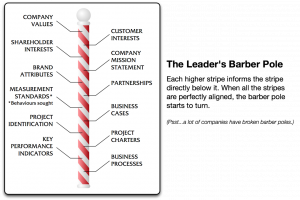 Leaders of all shapes and sizes know how difficult it is to keep their part of an organization running smoothly. In many cases, problems stem from breaks across the organization that could easily be solved with a simple model that shows where to look for guidance.
Leaders of all shapes and sizes know how difficult it is to keep their part of an organization running smoothly. In many cases, problems stem from breaks across the organization that could easily be solved with a simple model that shows where to look for guidance.
Start at the top with the company values. These are generally also the values of the person or people heading the organization. What’s important to them?
What values the organization has should inform what customer interests the company chooses to serve (value proposition). Ideally, the company values and customer interests should attract a certain kind of shareholder.
With those three pieces locked in place, a mission statement should develop. This statement should clearly spell out the things that are important to the company, the customer, and the shareholders. This is necessary to shape everything that fits below. Oftentimes, new leadership neglects to rephrase their mission statement and the barber pole breaks.
Brand attributes are next. These are a handful of key words that describe the heart of the company. Brand attributes work externally (describing the company to the customer and third parties) and internally (describing the company to the staff). Presenting one set of brand attributes to everyone keeps the organization in shape. Many companies are still discovering brand attributes and learning why they’re so important.
With the company identity determined, it can choose what kinds of partnerships to enter into, and will also attract certain kinds of prospective partners who share similar values. Strategic alliances are likely to be much more long-lasting because of the positions they share.
All of the above (including synergies brought by any partners) will merge to define behaviours the organization seeks in its people. Standards can be developed to help in hiring practices, and day-to-day operations of the company. Setting performance measurements will aid in the development reward and guidance programs to keep the people working towards the same goals.
The business now has an adequate platform to develop business cases for projects that align with the rest of the organization. They can draw on higher level stripes to justify the project requirements.
With an assortment of business cases in hand, portfolio managers would ideally look to the stripes above to determine which projects to take on. Some projects would stand out as being perfect choices, and others merely nice-to-haves. Funding can be allocated accordingly.
With projects selected and approved, project managers can move in to develop charters that align with the rest of the barber pole. As new products and services are developed, key performance indicators should emerge that align with all of the above, and will ultimately result in day-to-day business processes for working with whatever the projects deploy.
When all of the stripes on the barber pole are perfectly aligned, the barber pole happily starts to spin. If you’re having trouble keeping things moving within your organization, check to see if any stripes are missing!
